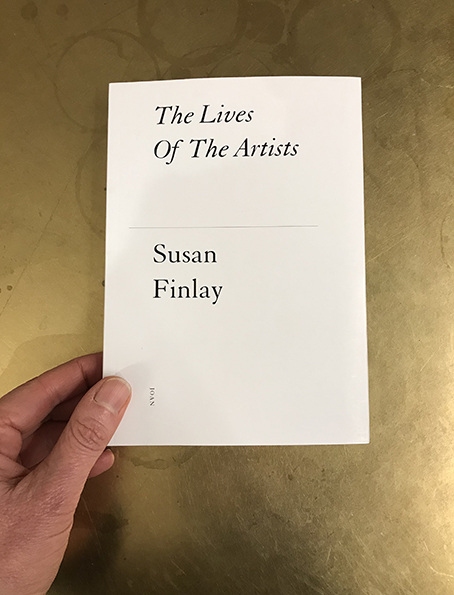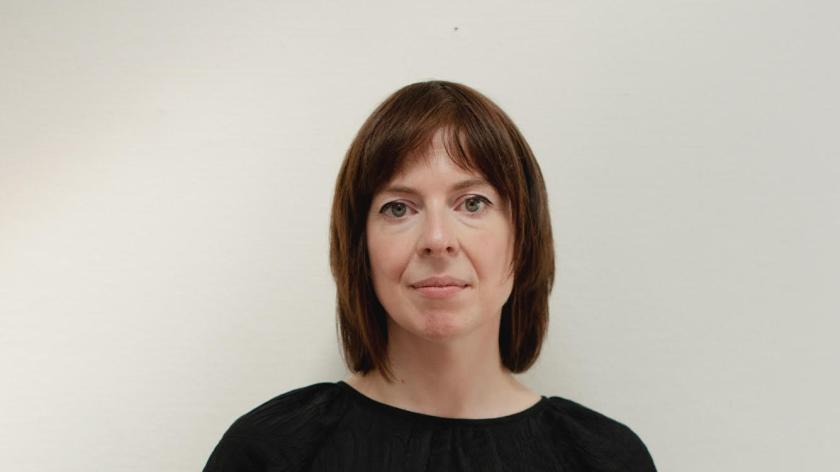Benvenuto Cellini’s My Life (1728) is not the artist-biography to which Susan Finlay’s The Lives of the Artists pays its most obvious homage, but it appears to have followed its advice. All men of achievement and honesty, Cellini argues, "should […] write in their own hands the story of their lives, but they should not begin such a fine undertaking until they have passed the age of forty."
Against Cellini’s implausibly-lived 58 years, readers learn in Finlay’s preface that she has only just entered his requisite age bracket. And as in My Life, The Lives of the Artists actually begins with a poem. Finlay’s "Ich Bin ein Berliner" is set in brittle, unrhymed stanzas, weighing up left-liberal pretend pieties against its speaker’s dishevelment, choosing "guardian angels / opium or statues of myths" over the belief "that art at least owes me a goodness".
Finlay’s memoir is partly a rejoinder to this idea: that art and its institutions are (or should be) ethically and materially affording. Finlay has little time, for instance, for the writers who have lucratively absorbed militant figures like David Wojnarowicz and Derek Jarman into their own broadsheet-friendly image, or any work "that looks or reads like a posh swot’s retelling". She also describes her experience with the HR departments at art schools:
I was forced to join in endless Professional Development Workshops, where I was underwhelmed by post-it notes (‘Susan, I see you’ve included socialism on your values tree, but I think what you really meant to write is equality and diversity, which we offer training in’).
But the memoir is also about owing people things: evading a life which has been requisitely professionally-developed, or a life which has attained unconditionally to the heroic freewheeling of Cellini’s first-person singular (though it keeps some of My Life’s occupational fluidity and mistrust of patrons). Moving between prose, poetry, script, excerpted essay and excerpted rejection email, The Lives of the Artists tallies up and settles various intellectual and material debts. And so Finlay’s possible and actually-existing lives accumulate, moving across tense and medium: there is her life as an artist, on the one hand, but also her life as a writer, a friend and sometimes-girlfriend, a bookseller, a Boots cashier, a note-taker for Child Protection. The memoir attains to a kind of comedy of errors, in the formal sense: a set of love themes, aspirations and misrecognitions produced as Finlay dons her various professional armatures. In one version of Finlay’s life, much is owed to the girls who chain-smoked Sobranies on a bus in Nottingham when she was a teenager, of whom she admired enough to follow to sixth form college, where she took Art and Photography A Levels. In other lives – the ones imagined for her by colleagues at Boots or pretended-to in a rejected article about writing a libretto – she is studying for a beauty qualification and has children and knows a lot about Iris Murdoch and JS Bach.
of whom she admired enough to follow to sixth form college, where she took Art and Photography A Levels. In other lives – the ones imagined for her by colleagues at Boots or pretended-to in a rejected article about writing a libretto – she is studying for a beauty qualification and has children and knows a lot about Iris Murdoch and JS Bach.
In this, the memoir owes something of itself to the plot and psychoanalytic freight of Finlay’s most recent novel, The Jacques Lacan Foundation (2022). It was a White Review Book of the Year, and concerns Lettuce Croydon-Smyth (née Nicki Smith): a working class girl from London who dresses up as Kate Moss and has blagged a role as a translator of a lost Lacan notebook at a Texan university, despite not having read any of his work. Against the formal closure possible in her fiction, however, Finlay’s memoir contends with the lack of generic legibility of "a life", particularly one being lived without stable or inherited income: as its ending makes clear, it is only due to PhD funding that the memoir – as material fact – exists. In a chapter on film and falling in love at first sight, she describes this formal disparity particularly astutely:
Whereas the truth is far simpler: there have been two occasions when I fell in and out of love within an hour which would be more like a film than either real life as it is meant to be lived, or a painting is, if the filmic hour wasn’t intended, in most cases, to indicate that a great amount of time is passing.
Film, painting, segments of Finlay’s actual biography: so much of what is in The Lives of the Artists is really nothing like a life. Rather, there are a set of often-disappointing counterfactual shapes: loose details of a breakup with a long term partner; the fact that Zwemmer’s – the Charing Cross art bookshops where Finlay appears to have worked – closed down in 2003; also the fact that the chapter "Speaking as an Artist" was supposed to be given as a talk at Nottingham Trent University but was cancelled due to the initial coronavirus lockdown of 2020. There is also the immense disappointment of New Labour, the ascendency of which coincided with Finlay’s own coming of age. "Picture", Finlay writes, "my discovery of art, drugs, men, or a fictitious Britpop album called “Cool Britannia” – but the party had barely got going when the World Trade Centre collapsed". Particularly given the subject matter of her first novel, Our Lady of Everything (2019), this specific biographical conjunction opens out into more implicit negatives: the deaths of Afghani schoolchildren; the working class teenage boys – Finlay’s almost-contemporaries – who were so heavily targeted in the school recruitment campaigns of the British Army.
This formal and biographical capaciousness allows Finlay to articulate these kinds of material disparities without collapsing into appropriative ethical melodramas, nor into long passages comprised of Calvinistic non-sequiturs about "privilege". Though much of the book is suspicious of prescriptive artistic earnestness, it does not deny the things that might be gained in widening its material and imaginative possibilities. She describes how differently her further-education students reacted when given examples of paintings with black figures, painted by black artists; how her previous examples – as opposed to Kerry James Marshall’s Past Times (1997) and Lynnette Yiadom-Boakye’s Ambassador (2003) – had proposed a version of the life of the artist more obviously made in her image, rather than those of her students. Where a different composite portrait of the artist might lead, Finlay leaves open.
As such, there is little in The Lives of the Artists which comprises sustained argument or narrative. It is about the things that Finlay owes, loves and hates: a drily funny, sometimes beautiful, set of observations about the contemporary art world. Insistently provisional, Finlay’s memoir performs something of its own scaffolded, open-ended sense of the formal and material limits of the (written-down) life of the artist. As in Anne Boyer’s description of Lyn Hejinian’s equally diffuse My Life (1980), such an endeavour often amounts to "calling what isn’t a life a life and calling what isn’t one’s own life one’s own".
- The Lives of the Artists by Susan Finlay (JOAN Books, £12)
- More book reviews on theartsdesk















Add comment